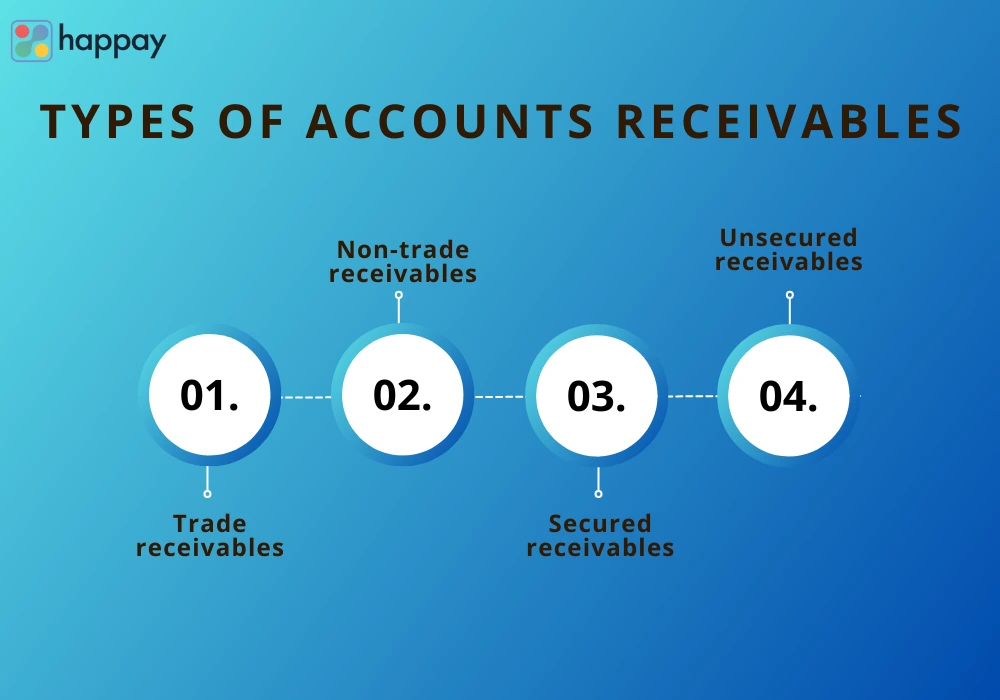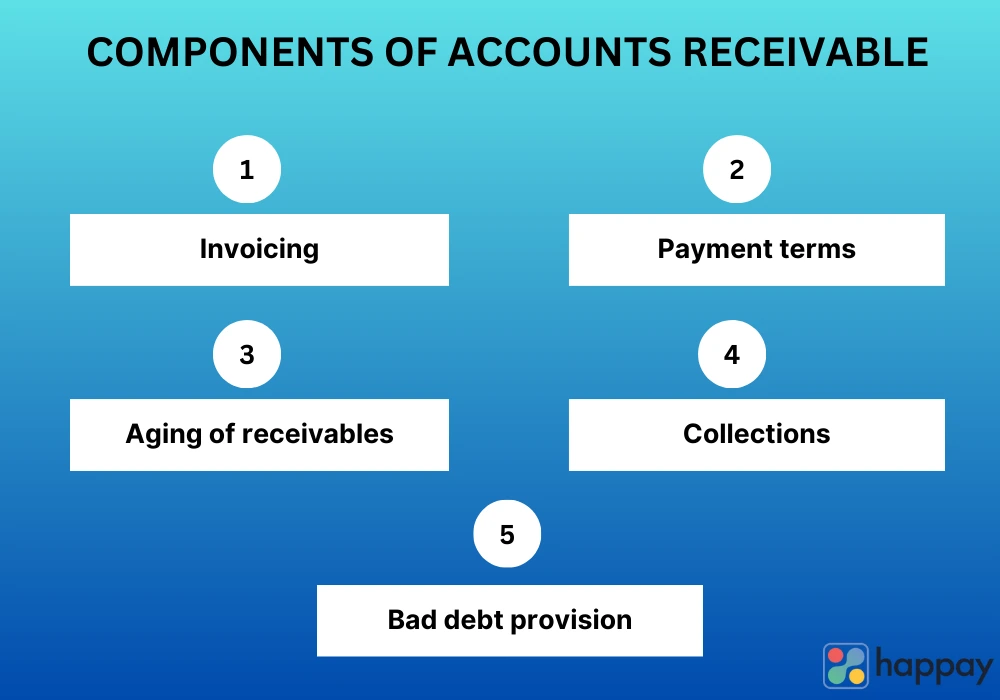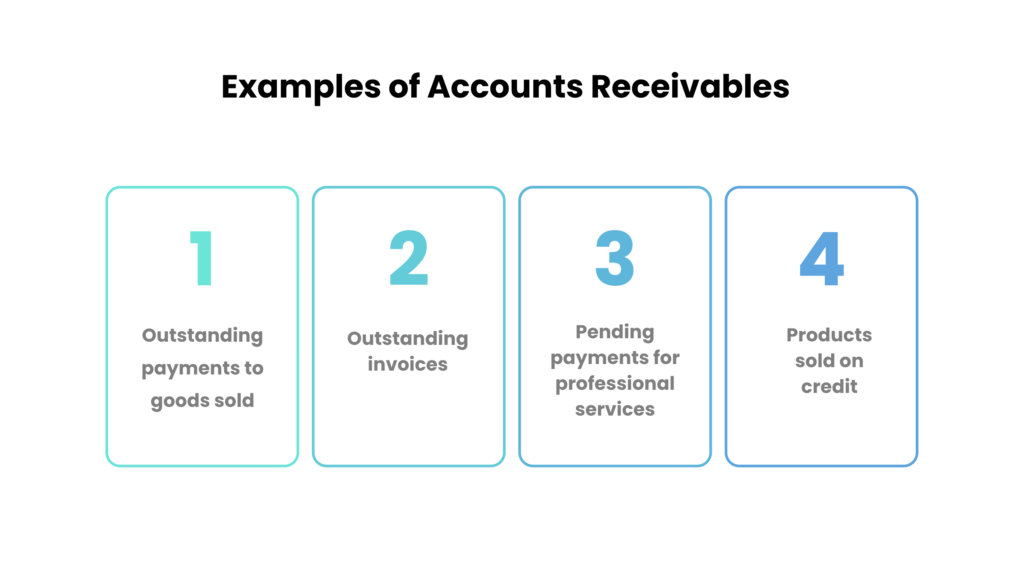Last Updated on November 28, 2025
What are accounts receivables?
Accounts receivables is the money due to a business by its customers or clients for goods or services that have been provided but not yet paid for. In other words, it represents the credit extended by the business to its customers, and the customers are expected to settle these outstanding payments within a specified period, typically 30, 60, or 90 days.
Why are accounts receivables important for a business?
Accounts receivables play a crucial role in maintaining a healthy cash flow for a business. They represent the money the business is entitled to and can be a significant portion of its current assets. Proper management of accounts receivables ensures that the business can meet its financial obligations, such as paying suppliers, employees, and other expenses, even if there is a delay in customer payments. Additionally, accounts receivables can provide valuable insights into customers’ creditworthiness and the business’s overall financial health.
Quick Read: 10 Best Accounts Payable (AP) Software
Role of accounts receivables in business operations
Accounts Receivables influence various aspects of a business’s operations. Some key roles they play include:
1. Cash flow management
Accounts Receivables directly impact the cash flow of a business. Timely collection of outstanding payments ensures a steady cash inflow, which is essential for meeting day-to-day expenses and pursuing growth opportunities.
2. Risk management
Efficient management of accounts receivables involves assessing customers’ creditworthiness before extending credit. This helps minimize the risk of bad debts and potential losses due to customers defaulting on their payments.
3. Financial analysis
Accounts Receivables are crucial for financial analysis. By monitoring the aging of receivables, a business can identify trends, potential issues, and opportunities for improvement in its credit and collection policies.
Read About: 6 Best Cash Flow Management Software
Types of accounts receivables
There are different types of accounts receivables, each representing a unique scenario of credit extended to customers. The main types include:

1. Trade receivables
Trade receivables are amounts customers owe for selling goods or services as part of the normal course of business.
2. Non-trade receivables
Non-trade receivables encompass amounts owed to the business that are not directly related to its core operations. Examples include tax refunds, interest receivables, or reimbursements from third parties.
3. Secured receivables
Secured receivables are backed by collateral, meaning that the business holds long and short-term assets or guarantees as security if the customer fails to pay.
4. Unsecured receivables
Unsecured receivables do not have any specific collateral attached to them, making them riskier for the business in case of non-payment.
Components of accounts receivable
Accounts Receivable consist of various components that contribute to its overall structure. These components include:

1. Invoicing
Invoicing is the process of generating bills or invoices for the goods or services provided to customers. It includes details such as the amount due, payment terms, due date, and other relevant information.
2. Payment terms
Payment terms define the period within which customers are expected to settle their outstanding balances. Common payment terms include Net 30, Net 60, and Net 90, indicating the number of days within which the payment should be made.
3. Aging of receivables
The aging of receivables refers to categorizing outstanding invoices based on the number of days they have been overdue. It helps identify which payments are pending for extended periods and need immediate attention.
4. Collections
Collections involve the process of following up with customers to ensure timely payment. It may include sending reminders, making phone calls, or employing collection agencies for more severe delinquency cases.
5. Bad debt provision
Bad debt provision is an allowance set aside by the business to account for the likelihood of some customers defaulting on their payments. It helps in estimating the potential losses due to uncollectible accounts.
By structuring and managing these components effectively, businesses can optimize their accounts receivable processes and ensure better financial stability.
Read More: 12 Best Invoicing Software
10 Step accounts receivable processes and procedures
Managing accounts receivable is a critical part of a company’s financial operations. Below are ten steps outlining an effective accounts receivable process and procedures:
- STEP 1: Customer credit check
Before extending credit to a customer, a thorough credit check is performed to assess their creditworthiness and ability to pay. This step helps minimize the risk of potential bad debts.
- STEP 2: Setting credit terms
Clear credit terms are established, including the credit period (e.g., Net 30), early payment discounts, and late payment penalties. These terms are communicated to the customer during the sales process.
- STEP 3: Invoicing and billing
Invoices are generated promptly and accurately, providing detailed information about the goods or services rendered, payment due date, and any applicable discounts or penalties.
- STEP 4: Sending payment reminders
Timely payment reminders are sent to customers as the due date approaches to encourage prompt payments and reduce instances of late payments.
- STEP 5: Collections and follow-up
In case of late payments, a systematic collection process is initiated. This involves contacting customers, sending demand letters, and employing collection agencies if necessary.
- STEP 6: Aging of receivables analysis
Regular analysis of the aging of asset accounts helps identify overdue accounts and prioritize collection efforts based on the time past due.
- STEP 7: Bad debt provisioning
A provision for potential bad debts is set aside based on historical data and credit risk assessments to account for the likelihood of some customers defaulting on payments.
- STEP 8: Reconciliation and reporting
Accounts receivable records are reconciled with customer payments, and periodic reports are generated to monitor the overall status of receivables and identify any discrepancies.
- STEP 9: Bad debt recovery or write-offs
Efforts are made to recover bad debts, and if recovery is deemed unlikely, the debts are written off as losses in the financial records.
- STEP 10: Continuous improvement
The accounts receivable process is regularly evaluated, and improvements are implemented to enhance efficiency, reduce late payments, and optimize cash flow management.
Must Read: 10 Best Expense Management Software and Tools
Accounts receivable examples

Accounts receivable examples include outstanding payments for goods sold to customers on credit, professional services rendered with payment pending, and outstanding invoices for products delivered but not yet paid for.
Key metrics and indicators for accounts receivable
Monitoring key metrics and indicators is crucial for effective accounts receivable management. Some important metrics include:
1. Days sales outstanding (DSO)
DSO measures the average number of days it takes for a business to collect its accounts receivable. A lower DSO indicates more efficient collections and better cash flow management.
2. Average collection period
The average collection period represents the average time taken by customers to pay their invoices. It helps in evaluating the effectiveness of credit policies and collection efforts.
3. Receivables turnover ratio
The receivables turnover ratio calculates how many times during a period accounts receivables are collected and replaced. A higher turnover ratio indicates effective management of receivables.
4. Aging of accounts receivables
The aging of accounts receivables categorizes outstanding invoices based on the time they have been unpaid. It helps identify overdue accounts and prioritize collection efforts.
5. Bad Debt Provision and write-offs
The bad debt provision is an estimate of potential losses due to uncollectible accounts, while write-offs represent the actual amounts deemed uncollectible and removed from the accounts receivable balance.
Also, Read: 11 Best Online Business Payment Solutions
Importance of accounts receivables in financial statements
- Balance sheet impact: Accounts receivable is listed as a current asset on the balance sheet, representing money owed to the company. It affects the overall liquidity and financial health of the business.
- Income statement impact: Accounts receivable is directly related to revenues and is reflected as sales in the income statement. Late payments or bad debts can impact the company’s reported revenue and profitability.
- Cash flow statement impact: Accounts receivable affects the cash flow statement as it represents cash inflows from credit sales. Efficient collections improve cash flow, while delayed payments can lead to cash flow challenges.
- Ratio analysis and performance evaluation: Accounts receivable metrics, such as DSO and receivables turnover ratio, are used in ratio analysis to assess the efficiency of collections and credit management. They are essential for evaluating a company’s financial performance and creditworthiness.
Accounts receivables financing and factoring
- Bank loans and lines of credit: Businesses can use their accounts receivable as collateral to secure bank loans or lines of credit, providing immediate access to cash while waiting for customer payments.
- Factoring services: Factoring involves selling accounts receivable to a third-party financial institution at a discounted rate, enabling the business to receive immediate cash while the factor assumes the responsibility of collecting from customers.
- Invoice discounting: Invoice discounting allows businesses to borrow money against their accounts receivable without selling them outright. The business retains control of collections but receives immediate funds.
- Asset-based lending: Asset-based lending uses accounts receivable as collateral to secure a revolving line of credit. The credit limit is determined based on the value of outstanding invoices.
- Benefits and considerations: Accounts receivable financing options provide businesses with improved cash flow, working capital for expansion, and risk mitigation against bad debts. However, they may involve additional costs and impact customer relationships.
Accounts receivable challenges and solutions
- Late payments and delinquent accounts: Late payments can strain cash flow and disrupt business operations. Implementing effective collection strategies, offering incentives for early payments, and building strong customer relationships can address this challenge.
- Managing credit risk and minimizing bad debts: Proper credit risk assessment, setting appropriate credit limits, and monitoring customer creditworthiness can help minimize the risk of bad debts and defaulting customers.
- Resolving disputes and customer issues: Promptly addressing customer disputes and issues can prevent payment delays and maintain positive customer relationships. Effective communication and conflict resolution are essential in this regard.
Best pracitces for effective accounts receivable management
- Credit risk assesment and monitoring: Regularly assess and monitor the creditworthiness of customers before extending credit. Use credit reports, financial statements, and past payment histories to make informed decisions. Continuously monitor customer payment behaviors to identify potential credit risks and take appropriate actions.
- Timely invoicing and billing: Generate and send invoices promptly after goods or services are delivered. Ensure that invoices are accurate and contain all relevant details, such as payment terms, due date, and itemized charges. Timely and clear billing helps encourage prompt payments from customers.
- Effective collection strategies: Develop a systematic and courteous collection process to follow up on overdue accounts. Implement payment reminders, escalation procedures, and payment negotiation strategies. A well-defined collection strategy can help improve cash flow and reduce the number of delinquent accounts.
- Customer relationship management: Maintain open and transparent communication with customers regarding their accounts. Build strong relationships to better understand their needs and address any payment issues promptly. A positive customer experience can lead to more reliable and timely payments.
- Continuous process improvement: Regularly review and evaluate the accounts receivable management process. Identify areas for improvement, streamline workflows, and implement automation where possible. Continuous improvement ensures efficiency and effectiveness in managing accounts receivable.
Legal and regulatory considerations
- Credit and collection laws: Stay compliant with local, regional, and national credit and collection laws. Understand debt collection practices, interest rate regulations, and any restrictions on credit extension to protect the business from legal issues.
- Compliance with financial reporting standards: Adhere to financial reporting standards while recording accounts receivable in financial statements. Accurate and transparent reporting ensures compliance with accounting principles and builds trust with stakeholders.
- Impact of tax regulations: Understand the tax implications related to accounts receivable, including potential deductions and taxes on bad debt write-offs. Compliance with tax regulations is essential for accurate financial planning and reporting.
- Consumer protection and privacy laws: Ensure compliance with consumer protection laws that govern fair debt collection practices and safeguard customer information. Protecting customer privacy is critical to maintaining trust and avoiding legal issues.
Suggested Read: Financial Planning: What is it, Types, Objectives, Steps & Benefits
Technology solutions for managing accounts receivables
1. Accounts receivables software
Utilize specialized accounting software designed for managing accounts receivable. These tools help track outstanding balances, automate invoicing, and generate reports for better financial analysis.
2. Automation and integration
Implement automation to streamline accounts receivable processes, such as invoice generation, payment reminders, and collections. Integration with other systems, such as customer relationship management and financial systems, enhances efficiency and accuracy.
3. Electronic invoicing and payments systems
Embrace electronic invoicing and offer multiple payment options to customers, such as online payments, credit card payments, or electronic fund transfers. Electronic systems improve convenience and accelerate payment processing.
4. Data analytics and reporting tools
Use data analytics to gain insights into accounts receivable trends, customer payment behaviors, and collection performance. Reporting tools help track key performance indicators and make data-driven decisions.
Future trends and innovations in accounts receivables
1. Artificial intelligence and machine learning
AI and machine learning algorithms can be used to predict customer payment behavior, identify high-risk accounts, and optimize collection strategies for improved efficiency and reduced bad debts.
2. Blockchain technology
Blockchain can enhance security and transparency in financial transactions, leading to more secure invoicing, faster payment processing, and reduced fraud in accounts receivable management.
3. Digital transformation and remote work
The increasing digitization of financial processes enables remote work capabilities, allowing accounts receivable teams to manage tasks efficiently from anywhere and collaborate effectively with other departments.
4. Predictive analytics and risk management
Predictive analytics can help forecast future cash flows, identify potential credit risks, and optimize working capital management. It enables businesses to proactively address challenges and seize growth opportunities.
Read About: Top 6 Enterprise Payment Software
Conclusion
Effective accounts receivable management is crucial for maintaining a healthy cash flow and financial stability. Businesses can optimize their accounts receivable processes and drive long-term success by implementing best practices, staying compliant with legal and regulatory requirements, leveraging technology solutions, and embracing future trends.
FAQs
AR stands for “Accounts Receivable.” It refers to the money owed to a business by its customers or clients for goods or services that have been provided but not yet paid for.
Accounts Receivable (AR) is the amount of money that a business is entitled to receive from its customers or clients for goods sold or services rendered on credit. It represents a current asset on the balance sheet and is a crucial component of a company’s working capital.
AR (Accounts Receivable) and AP (Accounts Payable) are both important aspects of a company’s financial management, but they represent opposite scenarios:
Accounts Receivable (AR): Represents money owed to the company by its customers for goods or services sold on credit.
Accounts Payable (AP): Represents the money that the company owes to its suppliers or vendors for goods or services purchased on credit.
An accounts receivable journal entry is a record of a business transaction related to accounts receivable. For example, when a sale is made on credit, the journal entry typically involves debiting Accounts Receivable and crediting Sales Revenue.
In accounting, accounts receivable refer to the outstanding amounts due to a business for goods sold or services rendered on credit. It represents the credit extended by the company to its customers, and it is an essential aspect of managing a company’s cash flow and financial health.
Businesses generate accounts receivable by providing goods or services to customers on credit. Instead of receiving immediate payment at the time of sale, the customers are given a specified period (e.g., 30 days, 60 days) to settle their outstanding balances.
Accounts Receivable: Represents the money owed to the company by its customers for goods or services sold on credit. It is a current asset on the company’s balance sheet.
Revenue: Represents the total income the company earns from its core business operations, including cash and credit sales. Revenue is reported on the income statement and contributes to the company’s profitability.
Common terms and conditions for accounts receivable include specifying the credit period (e.g., Net 30, Net 60), offering early payment discounts, setting late payment penalties, and outlining the consequences of defaulting on payments.
Accounts receivable can significantly impact cash flow. If customers delay their payments, it can lead to reduced cash inflow, affecting the business’s ability to meet its financial obligations and invest in growth opportunities.
Effective accounts receivable collection management involves setting clear credit policies, sending timely payment reminders, establishing a systematic collection process, and maintaining open communication with customers to resolve any payment issues promptly.
Delinquent accounts receivable can result in delayed cash flow, increased financial stress, difficulties in paying suppliers and employees, potential write-offs, and damage to customer relationships and business reputation.
Businesses can minimize the risk of bad debts in accounts receivable by conducting thorough credit checks on customers, setting appropriate credit limits, establishing clear payment terms, actively monitoring customer payment behavior, and promptly addressing any signs of financial distress from customers.
Yes, there are legal considerations when dealing with accounts receivable. Businesses must comply with debt collection laws, consumer protection regulations, financial reporting standards, and tax regulations to avoid legal issues and protect the company and its customers’ rights.
Businesses can automate and streamline their accounts receivable processes by implementing specialized accounts receivable software, utilizing automation tools for invoicing and payment reminders, integrating with other financial systems, and leveraging electronic payment systems for faster and more efficient transactions.
Yes, accounts receivable can be sold or factored to third-party financial institutions. Factoring allows businesses to sell their accounts receivable to a factor at a discounted rate, providing immediate cash flow, while the factor assumes the responsibility of collecting from customers.
Technology has a significant impact on accounts receivable management. It enables automation of repetitive tasks, improves data accuracy, enhances communication with customers, facilitates faster payment processing, and provides valuable data analytics for better decision-making.
Some best practices for improving accounts receivable processes include conducting regular credit risk assessments, setting clear credit terms, sending timely and accurate invoices, establishing an efficient collections process, actively monitoring accounts receivable aging, and continuously improving processes based on data analysis.
Various resources and tools are available to understand and manage accounts receivable effectively. These include accounting and finance textbooks, online courses and tutorials, industry publications, financial software providers, and professional organizations offering guidance and best accounts receivable management practices.
Debit refers to an accounting entry that records an increase in assets or expenses or a decrease in liabilities or equity on a company’s financial statements. It is typically represented on the left side of an account and is an essential aspect of double-entry bookkeeping.
Bookkeeping is the process of recording and organizing financial transactions and activities of a business. It involves maintaining accurate and systematic records of income, expenses, assets, liabilities, and equity, and plays a fundamental role in generating financial statements and reports.
Accrual accounting is an accounting method that recognizes revenue when it is earned and expenses when they are incurred, regardless of when the actual cash transactions occur. It aims to match income and expenses to the specific accounting periods in which they are associated, providing a more accurate picture of a company’s financial performance.
Accounts receivable encompass outstanding payments that a business is owed for goods or services provided to customers on credit. Some examples include invoices issued to clients who have not made their payments yet, outstanding bills for services rendered, or pending payments from customers with whom the company has credit arrangements.
CPA stands for Certified Public Accountant. It is a professional designation earned by accountants who have met specific education, examination, and experience requirements in their respective jurisdictions. CPAs have the authority to offer a range of accounting services, including financial audits, tax planning, and consulting, and they play a crucial role in ensuring financial integrity and compliance for businesses and individuals.










Discussion about this post